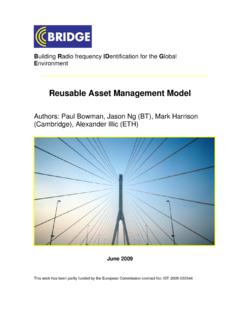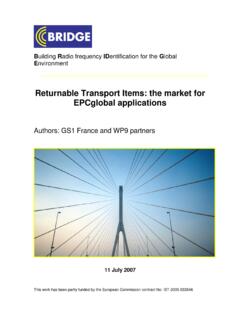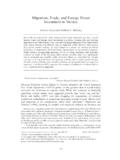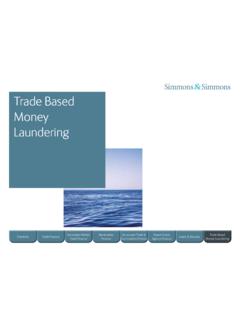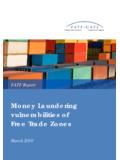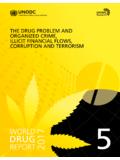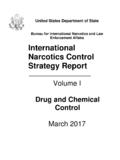Transcription of Problem-Analysis Report on Counterfeiting and …
1 Building Radio frequency IDentification for the Global Environment Problem-Analysis Report on Counterfeiting and illicit trade Authors: ETH Zurich, SAP Research 11 July 2007 This work has been partly funded by the European Commission contract No: IST-2005-033546 About the BRIDGE Project: BRIDGE (Building Radio frequency IDentification for the Global Environment) is a 13 million Euro RFID project running over 3 years and partly funded ( 7,5 million) by the European Union. The objective of the BRIDGE project is to research, develop and implement tools to enable the deployment of EPCglobal applications in Europe. Thirty interdisciplinary partners from 12 countries (Europe and Asia) are working together on : Hardware development, Serial Look-up Service, Serial-Level Supply Chain Control, Security; Anti- Counterfeiting , Drug Pedigree, Supply Chain Management, Manufacturing Process, Reusable Asset Management, Products in Service, Item Level Tagging for non-food items as well as Dissemination tools, Education material and Policy recommendations.
2 For more information on the BRIDGE project: This document: This Report will provide a problem analysis of product Counterfeiting and illicit trade as a first step towards making use of the potential of networked RFID technology to counter the problem of illicit trade . Disclaimer: This document results from work being done in the framework of the BRIDGE project. It does not represent an official deliverable formally approved by the European Commission. Copyright 2007 by ETH Zurich, SAP Research, All rights reserved. The information in this document is proprietary to these BRIDGE consortium members. This document contains preliminary information and is not subject to any license agreement or any other agreement as between with respect to the above referenced consortium members. This document contains only intended strategies, developments, and/or functionalities and is not intended to be binding on any of the above referenced consortium members (either jointly or severally) with respect to any particular course of business, product strategy, and/or development of the above referenced consortium members.
3 To the maximum extent allowed under applicable law, the above referenced consortium members assume no responsibility for errors or omissions in this document. The above referenced consortium members do not warrant the accuracy or completeness of the information, text, graphics, links, or other items contained within this material. This document is provided without a warranty of any kind, either express or implied, including but not limited to the implied warranties of merchantability, satisfactory quality, fitness for a particular purpose, or non-infringement. No licence to any underlying IPR is granted or to be implied from any use or reliance on the information contained within or accessed through this document. The above referenced consortium members shall have no liability for damages of any kind including without limitation direct, special, indirect, or consequential damages that may result from the use of these materials.
4 This limitation shall not apply in cases of intentional or gross negligence. Because some jurisdictions do not allow the exclusion or limitation of liability for consequential or incidental damages, the above limitation may not apply to you. The statutory liability for personal injury and defective products is not affected. The above referenced consortium members have no control over the information that you may access through the use of hot links contained in these materials and does not endorse your use of third-party Web pages nor provide any warranty whatsoever relating to third-party Web pages. BRIDGE Building Radio frequency IDentification solutions for the Global Environment Problem-Analysis Report on Counterfeiting 3/55 1 4 Motivation and goals of this 4 5 Structure of this 5 2 Aspects of Counterfeiting and illicit 6 Terminology and 6 9 General extent of 9 Industry specific extent of 10 Drivers and enablers of 11 Roles of different 13 Dangers of counterfeit 15 Overview of existing anti- Counterfeiting 17 Distribution channels and parallel 18 Structure and dimensions of parallel 18 Drivers and enablers of parallel 18 Roles of different actors in parallel Legal status of parallel trading in different 20 Findings of this 22 3 Counterfeiting and illicit trade in different 23 Information technology 23 Automotive 24 Life
5 Sciences and pharmaceutical 28 United States of 30 Developing 30 European 31 Aerospace 32 Luxury goods 35 Consumer goods industry and 40 Findings of this 43 4 Impact of Counterfeiting and illicit 44 Direct effects on 44 Indirect effects on 45 Impact on 45 Impact on 45 Findings of this 46 5 47 6 49 Appendix 53 Appendix 55 BRIDGE Building Radio frequency IDentification solutions for the Global Environment Problem-Analysis Report on Counterfeiting 4/55 1 Introduction Counterfeiting and product piracy constitute a serious and ever growing problem against legally run businesses and owners of intellectual property rights. Counterfeiting is not specific to any industry but it affects a large number of sectors such as the music, software, and luxury goods industries, and also pharmaceutical industry, automobile industry, fast moving consumer goods industry, and toys.
6 According to the International Chamber of Commerce, [c]ounterfeiting and piracy are growing exponentially in terms of volume, sophistication, range of goods, and countries affected - this has significant negative economic and social impact for governments, consumers and businesses [..]. Product Counterfeiting has many victims: Different kinds of counterfeit products threaten the health and safety of end-users and consumers, sometimes with the most serious consequences. Legally run businesses and governments are affected by a number of direct and indirect economic losses which decreases the welfare of affected societies. By understanding and continuously surveying the problem and available countermeasures, however, companies can protect their products and mitigate the negative impacts and ensure the safety of consumers.
7 In addition, alongside with the development of technologies that enable Counterfeiting on an industry scale, technology also allows for novel countermeasures. Most importantly, mass-serialization is changing the way product information is managed by giving unique identities to individual items. One implication of this higher level of information granularity is that the physical security of products can be improved in terms of novel anti- Counterfeiting techniques, as well as with the detection of illicit trade activities. The potential of RFID and the EPCnetwork in enabling these novel anti- Counterfeiting and anti-fraud techniques is well recognized. Even though it seems that there will never be one silver bullet solution against illicit trade , industries and academia see mass-serialization among the most promising single countermeasures.
8 There are two major reasons for using EPCnetwork technology in anti- Counterfeiting : First, RFID allows for new, automated and secure ways to efficiently authenticate physical items. Secondly, as many companies invest in networked RFID technology for varying supply chain applications, the item-level data will be gathered in any case so why not using it to find counterfeit products? This Report will provide a problem analysis of product Counterfeiting and illicit trade as a first step towards making use of the potential of networked RFID technology to counter the problem of illicit trade . Motivation and goals of this Report Different sides of the problem of illicit trade are partially addressed in existing literature, but complete industry and problem wide analysis that systematically takes into account all aspects of the problem and different industry branches does not exist.
9 This Report will first of all support research and development of counter measures within the BRIDGE project, but also practitioners and academics working in the field in general. The goals of this Report are to give an overview of different aspects of the problem of illicit trade , to present the dangers of counterfeit goods, to define terminology so that the problem can be formally addressed, to BRIDGE Building Radio frequency IDentification solutions for the Global Environment Problem-Analysis Report on Counterfeiting 5/55 present the drivers and enables behind counterfeit trade , and to study the structure and extent of the problem . This Report will also present Counterfeiting scenarios in different industry branches to provide valuable input for the design of industry specific countermeasures.
10 Finally, understanding the trade with counterfeit goods will serve as input for the development of models quantifying the economic impact of various aspects of illicit trade , which will be covered in greater details in the adjacent research project SToP. Methodology To achieve the abovementioned goals, the following methodology was adopted: The first stage was to review available literature that covers the topic. As a second stage, we conducted in-depth interviews with experts from different companies in order to acquire industry specific information, as well as to validate information from the literature. These interviews were semi-structured and the used interview guideline can be found in the appendixes of this Report . The interviews were conducted either face-to-face or over the telephone.


